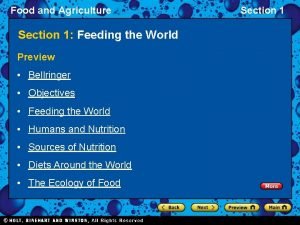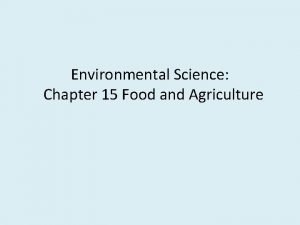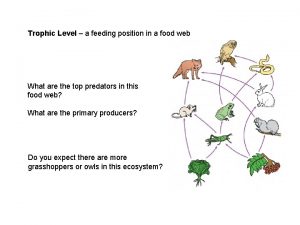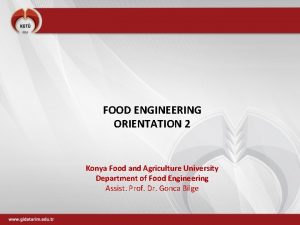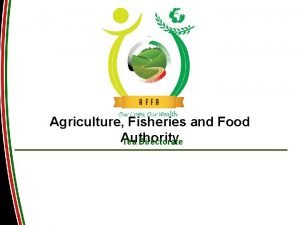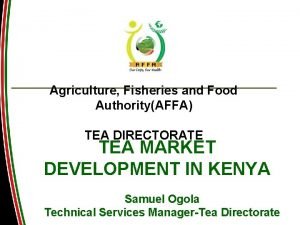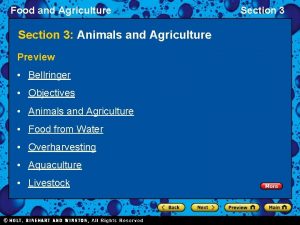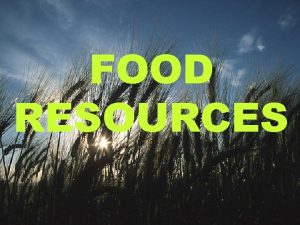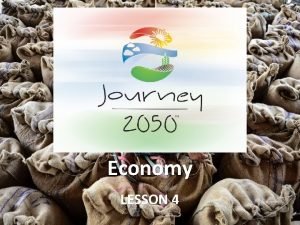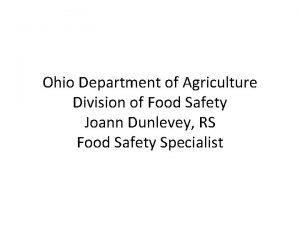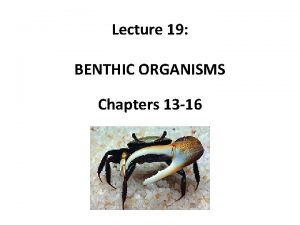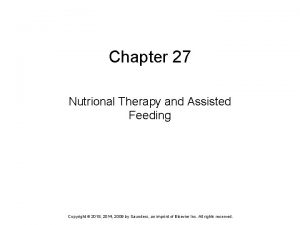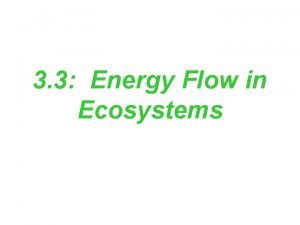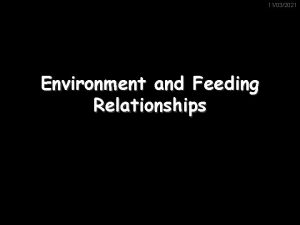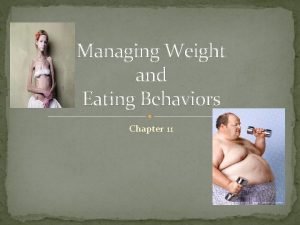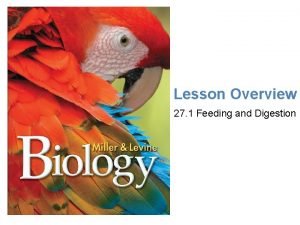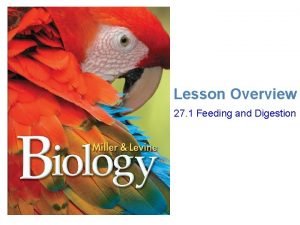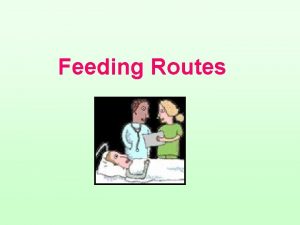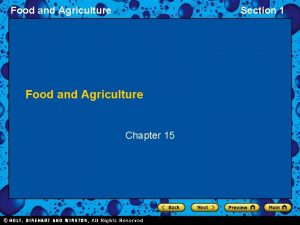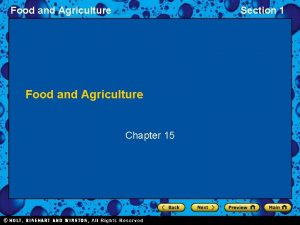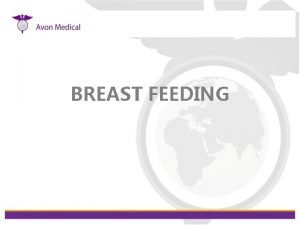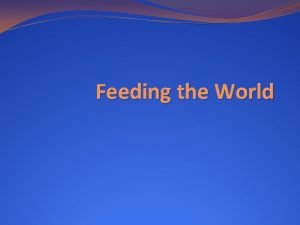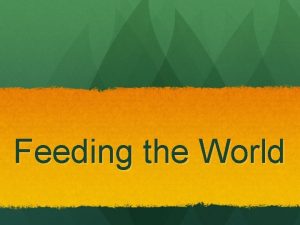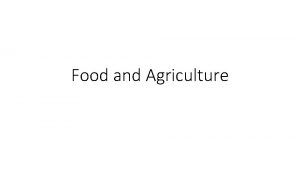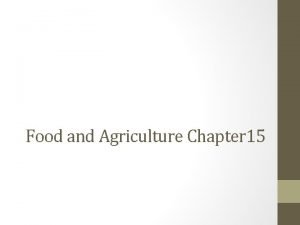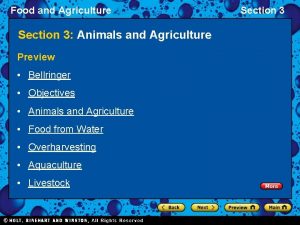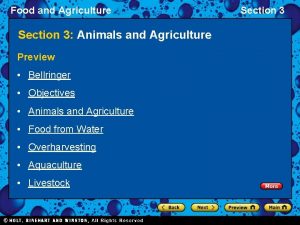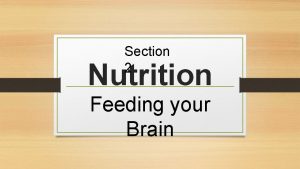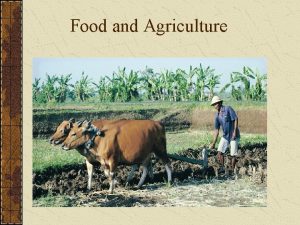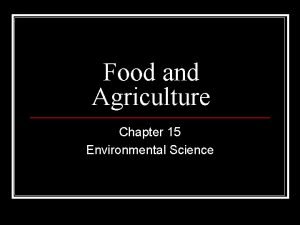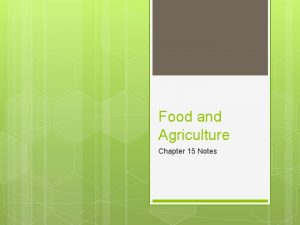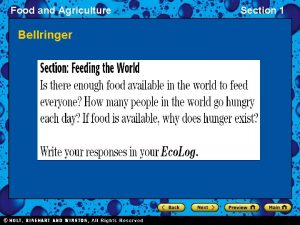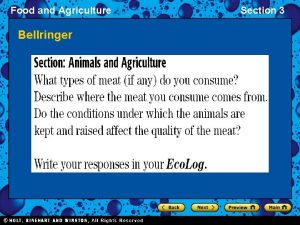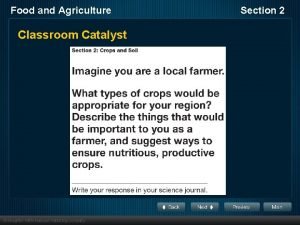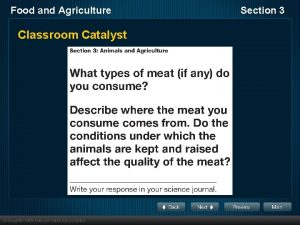Food and Agriculture Section 1 Feeding the World


























- Slides: 26

Food and Agriculture Section 1: Feeding the World Preview • Bellringer • Objectives • Feeding the World • Humans and Nutrition • Sources of Nutrition • Diets Around the World • The Ecology of Food Section 1

Food and Agriculture Section 1: Feeding the World Preview, continued • Food Efficiency • Old and New Foods • World Food Problems • Unequal Distribution • Droughts and Famines • The Green Revolution Section 1

Food and Agriculture Bellringer Section 1

Food and Agriculture Section 1 Objectives • Identify the major causes of malnutrition. • Compare the environmental costs of producing different types of food. • Explain how food distribution problems and drought can lead to famine. • Explain the importance of the green revolution.

Food and Agriculture Section 1 Feeding the World • Famine is the widespread malnutrition and starvation in an area due to a shortage of food, usually caused by a catastrophic event, such as drought. It can also be caused by food production not matching population growth as well as distribution problems caused by political turmoil. • Modern agriculture practices provide most of the world’s population with enough food to survive. • However, some of these practices can cause environmental damage that eventually makes growing food crops more difficult.

Food and Agriculture Section 1 Humans and Nutrition • The human body uses food both as a source of energy and as a source of materials for building and maintaining body tissues. • The amount of energy that is available in food is expressed in Calories. One Calorie is equal to 1, 000 calories or one kilocalorie. • The major nutrients we get from food are carbohydrates, proteins, and lipids. Our bodies need smaller amounts of vitamins and minerals to remain healthy.

Food and Agriculture Humans and Nutrition Section 1

Food and Agriculture Section 1 Humans and Nutrition • Malnutrition is a disorder of nutrition that results when a person does not consume enough of each of the nutrients that are needed by the human body. • There are many forms of malnutrition. For example, humans need to get 8 essential amino acids from proteins. This is easily done if a variety of foods is eaten. However, in some parts of the world, the only sources of food may be corn and rice, which contain protein, but lacks one of the essential amino acids. Amino acid deficiency can result from such a limited diet.

Food and Agriculture Section 1 Sources of Nutrition • Diet is the type and amount of food that a person eats. A healthy diet is one that maintains a balance of the right amounts of nutrients, minerals, and vitamins. • The foods produced in the greatest amounts worldwide are grains, plants of the grass family whose seeds are rich in carbohydrates. • Besides eating grains, most people eat fruits, vegetables, and smaller amounts of meats, nuts, and other foods that are rich in fats and proteins.

Food and Agriculture Sources of Nutrition Section 1

Food and Agriculture Section 1 Diets Around the World • People worldwide generally consume the same major nutrients and eat the same basic kinds of food. • But, diets vary by region. • People in more developed countries tend to eat more food and a larger proportion of proteins and fats than people in less developed countries.

Food and Agriculture Diets Around the World Section 1

Food and Agriculture Section 1 The Ecology of Food • As the human population grows, farmland replaces forests and grasslands. • Feeding everyone while maintaining natural ecosystems becomes increasingly difficult. • Different kinds of agriculture have different environmental impacts and different levels of efficiency.

Food and Agriculture Section 1 Food Efficiency • The efficiency of a given type of agriculture is a measure of the quantity of food produced on a given area of land with limited inputs of energy and resources. • An ideal food crop is one that efficiently produces a large amount of food with little negative impact on the environment.

Food and Agriculture Section 1 Food Efficiency • On average, more energy, water, and land are used to produced a Calorie of food from animals than to produce a Calorie of food from plants. • Animals that are raised for human use are usually fed plant matter, but because less energy is available at each level on a food chain, only about 10 percent of the energy from the plants gets stored in the animals.

Food and Agriculture Section 1 Food Efficiency • Thus, a given area of land can usually produce more food for humans when it is used to grow plants than when it is used to raise animals. • The efficiency of raising plants for food is one reason why diets around the world are largely based on plants. • However, meat from animals generally provides more nutrients per gram than most food from plants.

Food and Agriculture Section 1 Old and New Foods • Researchers hope to improve the efficiency of food production by studying plants and other organisms that have high yield. • Yield is the amount of crops produced per unit area. • Researchers are interested in organisms that can thrive in various climates and that do not require large amounts of fertilizer, pesticides, or fresh water. Some organisms have been a source of food for centuries, while other sources are just being discovered.

Food and Agriculture Section 1 World Food Problems • Some people become malnourished because they simply do not get enough food. • More food is needed each year to feed the world’s growing population. • World food production has been increasing for decades, but now food production is not increasing as fast as the human population is increasing.

Food and Agriculture World Food Problems Section 1

Food and Agriculture Section 1 Unequal Distribution • If all the food in the world today were divided equally among the human population, no one would have quite enough food for good health. • But food is not divided equally, and malnutrition is largely the result of poverty. Even in the United States, many poor people suffer from malnutrition. • Wars and political strife can also lead to malnutrition because they interrupt transportation systems.

Food and Agriculture Section 1 Droughts and Famines • A drought is a prolonged period during which rainfall is below average, and crops grown without irrigation may produce low yields or fail entirely leading to famine. • A drought is more likely to cause famine in places where most food is grown locally. • If a drought occurs, there may be no seed to plant crops the following year. The effects of a drought can continue for years.

Food and Agriculture Section 1 Droughts and Famines • People in a given area can usually survive one crop failure. They may have saved enough food from previous seasons, or they may have systems for importing food from elsewhere. • But several years of drought cause severe problems for any area of the world. • For example, after a long drought, the soil may be less able to support the production of food crops.

Food and Agriculture Section 1 The Green Revolution • Worldwide, between 1950 and 1970, increases in crop yields resulted from the use of new crop varieties and the application of modern agriculture techniques. • These changes were called the green revolution. Since the 1950 s, the green revolution has changed the lives of millions of people. • However, the green revolution also had some negative effects.

Food and Agriculture Section 1 The Green Revolution • For example, most new varieties of grain produce large yields only if they receive large amounts of water, fertilizer, and pesticides. In addition, the machinery, irrigation, and chemicals required by new crop varieties can pollute and degrade the soil if they are not used properly. • As a result of the overuse of fertilizers and pesticides, yields from green revolution crops are falling. The grain production in the U. S. has decreased since 1990, partly because the amount of water used for irrigation has decreased.

Food and Agriculture Section 1 The Green Revolution • In addition, the green revolution had a negative impact on subsistence farmers, or farmers who grow only enough food for local use. • Before the green revolution, subsistence farmers worked most of the world’s farms. • But they could not afford the equipment, water, ad chemicals needed to grow new crop varieties.

Food and Agriculture Math Practice Section 1
 Abbott feeding pump error codes
Abbott feeding pump error codes Section 1 feeding the world
Section 1 feeding the world Active reading section 3 animals and agriculture
Active reading section 3 animals and agriculture Feeding position in a food chain
Feeding position in a food chain Levels of nourishment in a food chain
Levels of nourishment in a food chain Konya food and agriculture university
Konya food and agriculture university Tea directorate
Tea directorate Ministry of food agriculture and fisheries denmark
Ministry of food agriculture and fisheries denmark Tea directorate
Tea directorate Section 3 animals and agriculture
Section 3 animals and agriculture Food resources world food problems
Food resources world food problems Unit 2 food food food
Unit 2 food food food Grazing food chain diagram
Grazing food chain diagram How does agriculture create ripples in the world
How does agriculture create ripples in the world Virginia department of agriculture and consumer services
Virginia department of agriculture and consumer services Ohio cottage food law label
Ohio cottage food law label Suspension feeding
Suspension feeding Chapter 27 nutritional therapy and assisted feeding
Chapter 27 nutritional therapy and assisted feeding Chapter 18 eating and feeding disorders
Chapter 18 eating and feeding disorders Feeding relationship showing one path of energy flow
Feeding relationship showing one path of energy flow Environment and feeding relationship
Environment and feeding relationship Oral placement therapy for speech clarity and feeding
Oral placement therapy for speech clarity and feeding Chapter 11 managing weight and eating behaviors
Chapter 11 managing weight and eating behaviors Lesson 11 feeding and digestion
Lesson 11 feeding and digestion Lesson 11 feeding and digestion
Lesson 11 feeding and digestion Hát kết hợp bộ gõ cơ thể
Hát kết hợp bộ gõ cơ thể Ng-html
Ng-html

